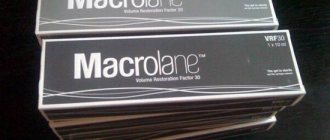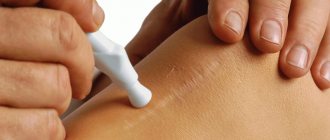When you can't do without surgery
Varicose veins are a serious and, unfortunately, very common disease. Especially in the modern world, with its sedentary lifestyle, unfavorable environment and genetic diseases.
Varicose veins are a vein disease associated with weakening of the internal valves and venous walls.
Blood flow in the veins slows down, stagnation occurs, causing the walls to stretch.
Because of this, veins begin to appear through the skin.
It looks very ugly, but that's not the worst thing. Much worse possible complications:
- pain and cramps in the legs;
- thrombophlebitis.
- trophic ulcers;
It is in order to avoid these complications or prevent their development that surgery is performed for varicose veins on the legs.
In what cases is surgery to remove leg veins prescribed? There are several options for surgical intervention.
- Severe heaviness in the legs, swelling, fatigue.
- Extensive damage to veins by varicose veins.
- Thrombophlebitis.
- Trophic ulcers.
Radical therapy methods
Radical intervention to remove pathologically deformed varicose veins is necessary, first of all, to normalize blood flow in the legs. Stagnation of blood in dilated veins can cause health-threatening complications such as thrombosis and thrombophlebitis. The need for surgery arises in the following cases:
- there is a strong swelling of the veins under the skin, they become lumpy and knotty,
- vascular damage extends to the area up to and above the knee,
- ulcers appear on the skin of the legs,
- there is severe swelling of the limbs,
- there is a burning sensation in the veins,
- pain symptoms occur.
The classic method of excision of pathological veins is surgery. In modern medical practice, phlebectomy is most often used, which is performed under intravenous anesthesia with mandatory hospitalization of the patient. This operation involves making surgical incisions to access the varicose vein, which is subsequently ligated, divided and removed. Treatment methods for varicose veins using surgery are quite traumatic for the patient.
Less traumatic methods of dealing with dilated veins include modern minimally invasive operations. Such operations include laser ablation, the peculiarity of which is that surgery is performed without the use of classical surgical instruments. After laser ablation there are no scars left. It is performed under local anesthesia by puncture.
Radiofrequency vein obliteration is also a modern method of treating varicose veins. The essence of the procedure is the thermal effect on the walls of the veins with a radio frequency signal.
There are several tips that need to be followed as time passes after surgery, regardless of the method used. To completely get rid of varicose veins after dilated veins are removed, you need to carry out recovery therapy. During this period, medication treatment is prescribed as a supplement. It helps prevent the formation of a blood clot or relapse of the disease. Using antiplatelet agents, they achieve blood thinning. At the same time, its fluidity improves and the ability of platelets to stick together is blocked. Blood clots stop forming. When using phlebotropic drugs, the condition of the venous walls improves, their elasticity improves, and permeability decreases. When taking phlebotonics, blood circulates better and inflammation decreases.
Should I have surgery?
Many people are afraid of any kind of surgery, but removing veins on the legs even sounds scary. A lot of questions and concerns immediately arise. And the main thing is how will the blood continue to rise to the heart if the veins are removed? In fact, only superficial veins are removed, while up to 90% of the blood flow passes through internal, stronger vessels that are not susceptible to varicose veins .
Before agreeing to surgery for varicose veins, you still need to weigh the pros and cons.
Important! If you still have any doubts, do not hesitate to ask questions to your doctor, he will explain, tell and show everything.
Modern medicine has reached a level where vein removal is completely safe.
Moreover, a correctly performed operation guarantees complete elimination of varicose veins.
Of course, provided that the patient follows all the doctor’s recommendations.
If you refuse surgery, you will have to be content with a slight relief from the pills. In addition, advanced varicose veins are a risk of developing thrombophlebitis . And this is already a deadly disease.
True, there are situations in which surgery is really not worth it. If the condition of the veins in the legs is too advanced, then, alas, surgery cannot be performed. The condition of the veins is assessed by a phlebologist and a vascular surgeon before removal. To do this, you need to do an ultrasound examination of the veins, an external examination and a blood test.
Also, surgery is not performed if the patient suffers from coronary artery disease or hypertension. In these cases, there is a high risk of complications during surgery. Skin damage, opened trophic ulcers and various skin diseases are also contraindications. So are infectious diseases. They need to be treated first.
Important! For elderly people and pregnant women from the second trimester, surgery is also contraindicated.
If a specialist, after all the research, insists on surgery, you still shouldn’t refuse. After surgery to remove varicose veins on the legs, there is a chance to get rid of the unpleasant and dangerous disease forever.
Where to have vein surgery
Particular attention should be paid to where exactly you will have the operation. Their further condition entirely depends on the qualifications of the doctor in whose hands your legs will be. Correctly performed surgical treatment of varicose veins of the lower extremities is completely safe .
Today, in almost every city there is an opportunity to choose a clinic and a doctor. What should you pay attention to?
- Clinic equipment . Modern equipment and suitable medications increase the chances of a successful outcome.
- Doctor's qualifications. Do not hesitate to ask where and how the specialist was trained, check all diplomas and certificates.
- Patient reviews . The Internet gives us the opportunity to get acquainted with real and varied patient reviews about the clinic and the doctor.
Prevention
When diagnosed with varicose veins, it is important for patients to strictly monitor their health and prevent the progression of the disease, otherwise the situation may end in an unpredictable outcome. To prevent varicose veins after surgery, you need to monitor your weight, eat right, lead a healthy, active lifestyle, and give up bad habits. If there are characteristic signs, it is forbidden to self-medicate and take medications at your own discretion. Only timely treatment under the supervision of a doctor will help get rid of the disease, prevent relapse and negative consequences.
How is the operation performed?
There are several different techniques for surgical vein removal.
Direct surgical intervention is the most proven, long-tested, but at the same time the most radical method.
The surgeon makes two incisions on the leg: in the groin area and on the ankle.
Additional, smaller incisions are made in the area of the main venous nodes. The vein is excised through these incisions .
The operation itself lasts about 2 hours. It can be performed under either local or general anesthesia. A thin wire, a venous extractor, is inserted through an incision in the groin, which is used to remove the vein. After the operation is completed, the incisions are carefully sutured. The main advantage of this method is that even a large vein with a very wide lumen can be removed in this way.
Important! The patient will be able to get to his feet within 5 hours after the operation.
Sometimes there is no need to remove the entire vein; it is enough to get rid of the affected part. In this case, a miniflebectomy is performed. Two small incisions are made in the area of the affected area of the vein, and through them this area is removed .
What to do after vein surgery? Follow all doctor's recommendations. They are very individual, and largely depend on the degree of neglect of the disease, individual characteristics and concomitant diseases.
Sclerotherapy
This is one of the newest methods of combating varicose veins. Its main advantage over the actual operation is the absence of incisions. Sclerotherapy of the veins of the lower extremities is carried out using syringes with a thin needle.
A sclerotant is injected into a vein. Under its influence, the inner layers of the vessel are destroyed, and the middle ones simply stick together. As a result, the vessel simply falls out of the bloodstream.
Attention! Within 1-2 days you will notice how the damaged vein disappears.
After such an operation, the patient comes to his senses much earlier. Within an hour he can get up and move around on his own. In addition, with sclerotherapy, there is less chance of developing hematomas at the injection site.
Laser vein removal
Another innovative method is laser surgery. This also involves making small punctures through which a laser LED is inserted into the vein .
It heats up the walls of blood vessels and glues them together. At the same time, under the influence of temperatures, all microorganisms die, which reduces the likelihood of developing an infection.
The consequences of laser leg vein removal are minimal. This procedure can be done literally on the way home after work, and the next day you can return to work.
Important! The disadvantages include low accessibility: the procedure is expensive, and not every clinic has the necessary equipment.
Rehabilitation and possible consequences
The postoperative period from leg vein surgery lasts literally a few hours. And the sooner the patient begins to move his legs, bend them, turn them, lift them, the shorter it will be. And the lower the risk of complications after surgery on the veins of the lower extremities.
It is necessary from the very beginning to stimulate blood flow in the remaining vessels, to promote the rapid rise of blood to the heart. You can also do this by placing your feet on a pad so that your feet are higher than your heart level.
The rehabilitation period after surgery to remove varicose veins of the lower extremities can last about two months . At this time, it is necessary to wear compression hosiery selected by a specialist.
As already mentioned, recommendations after surgery for varicose veins are very individual. However, some generalizations can still be made. In addition to wearing compression garments, it is important to:
- change your lifestyle to a more active one. Without this, varicose veins will return sooner or later;
- lose weight if you are overweight;
- do special exercises to strengthen the leg muscles;
- follow a diet for varicose veins;
- take medications for varicose veins.
The consequences of phlebectomy are usually minimal. Hematomas may appear in the area of incisions or punctures, however, as a rule, they quickly resolve. Some people who are prone to connective tissue overgrowth may develop scars at the incision sites. If you know that you have this characteristic, it is better for you to choose a less traumatic method.
After surgery to remove a vein in the leg, lumps and pain may occur. This happens extremely rarely, but it still happens sometimes. In this case, you must immediately consult a doctor.
Indications for surgery
The feasibility of an operation to remove varicose veins is determined by the doctor individually, depending on the stage of the pathology, the patient’s age, his weight, the presence of concomitant diseases and other characteristics of the body. Surgical treatment of varicose veins is carried out for the following symptoms:
- extensive vein lesions;
- severe swelling of the legs;
- abnormal expansion of veins under the skin;
- rapid fatigue of the legs, a person cannot stand for a long time;
- trophic ulcers;
- mechanical damage to the leg;
- disturbances of blood outflow in the lower extremities;
- acute thrombophlebitis.
In addition to the above indications for surgery for varicose veins, there are also contraindications. They can reduce the effectiveness of treatment to zero and even cause additional harm to the patient’s body. Surgery for varicose veins of the lower extremities is not prescribed for the following diagnoses:
- stage 3 hypertension;
- cardiac ischemia;
- inflammatory and purulent processes in the body;
- elderly age;
- pregnancy period;
- chronic skin diseases at the acute stage;
- oncological diseases and chemotherapy.
Before starting surgery, it is necessary to conduct a full examination of the patient; if there are contraindications, the doctor will individually develop a more gentle treatment regimen. It is important to follow the diet recommended by your doctor.










